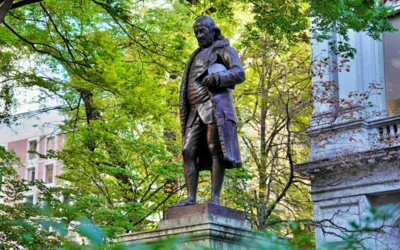- Rainbow Mountain’s vivid stripes come from mineral deposits—reds from rust, yellows from iron sulfide, greens from chlorite, purples from oxidized minerals.
- Hire local guides to support communities, benefit from their knowledge, and boost local livelihoods despite limited formal first-aid training.
- Avoid January–April rainy season; best hiking window is May through October for clearer skies and brighter colors.
- Acclimate in Cusco before ascending—altitude (17,000+ ft) risks sickness; descend immediately if symptoms worsen.
- Minimize environmental impact: vanpool, stay on trails, pack out waste, use wag bags, and respect Quechua cultural practices.
The colorful photos of Rainbow Mountain, Peru give this destination quite a bit to live up to.
Is it really all that these stunning photos show? Yes and no. Also known as Vivicunca, this mountain of seven colors has made waves over the past few years. With different mineral deposits striping this mountain with different shades of yellows, reds, greens, and oranges, there is something other-worldly happening here. But, this actually happens all throughout the Andes. Rainbow Mountain, Peru just happens to be the most accessible option, being just three hours from Cusco. So, many people and places will warn you of the over-tourism and dangers of hiking Rainbow Mountain. We want to explore the finding the healthy balance of seeing gorgeous things on this earth and caring for it. So, read on to figure out how to maximize your Rainbow Mountain, Peru adventure without making a big environmental footprint.
Preparing for Your Trek
Guides

Credit: Laila Goubron
Some of you may be keen on making it to the top all by yourself. If so, make sure to have all of the proper equipment to make your way up there. This spans from plenty of safe drinking water and snacks to solid hiking shoes and quite a bit of physical fitness. While we applaud your desire to be independent, you should consider paying a guide to take you up Rainbow Mountain, Peru. First off, the development of this natural habitat into a tourist site has given many of the locals' jobs. This, in turn, raises their standard of living. If you had enough money to make it to this remote part of Peru, you have enough money to buy breakfast from them and pay them to take you to the top.
Tours can pick you up from Cusco if you’d like the highest level of service. They will usually arrive at your hotel around 3 AM, as you need to start hiking early after the long drive. Once you get to the base of the mountain, they will feed you breakfast at their local village. When you’re ready, you’ll start the trek to the top. If you need to rent a horse, you can do that as well to assist you in getting to the summit. But, keep in mind that it is well worth hiring a guide as it is their land they are sharing with you.
When To Go
The Rainbow Mountain, Peru trail has been overrun by tourists faster than an infrastructure can be put in. This means the trails are not great, especially when it has been snowy or rainy lately. In Peru, January through April are the wettest months. We would strongly advise against planning a trip here at that time. Not only will it be potentially dangerous and miserable, but the colors that you’re seeking also won’t be as bright with the foggy skies. When May rolls around, it begins to dry out and stays so through October. This is the best time to plan a tour before light rain picks up again in November. Keep in mind that guides do like a steady salary and may not have your best interest and safety in mind when trying to book you even in the rainy season.
Altitude
Rainbow Mountain, Peru tops out at over 17,000 feet. This is incredibly high, which means you and your hiking partners will be susceptible to altitude sickness. The first step to mitigating this is spending a few days acclimating to the altitude in Cusco before you hike up Rainbow Mountain, Peru. As you ascend the mountain, you may begin to feel lightheaded, nauseous, or get a headache. This is the first sign of altitude sickness. Immediately take a break and drink water. This is happening due to your body not being able to cope with the lesser barometric pressure and a smaller amount of oxygen in the air. If you push through this without caring for your body, it could escalate to something much more dangerous.
If you keep pushing, you will become delirious and fluid can build up in your lungs and even your brain. This can turn deadly. Remember, you are a three-hour drive away from Cusco and getting to the top of Rainbow Mountain, Peru is not worth risking your life. You can always try again after acclimating more to the high altitude. There are some remedies and medications to alleviate some of the symptoms of altitude sickness, but they will only make you less uncomfortable, not fix the cause.
First Aid & Clothing
Your guides and the other locals most likely have been Alpaca herders for the past few generations. So, while the title of guide and their local knowledge is undeniable, they are not first aid certified like many guides elsewhere in the world. So, you need to be prepared yourself. If you are prone to twisting ankles or have had altitude sickness before, know your limits. You should also bring your own preventative safety things along. This would include a first aid kit and plenty of sunscreen. Remember, you’re close to the equator here and much closer to the sun, making sunburns and poisoning quite common here. On top of that, it can get quite warm, but also the wind can be quite cold at the top. It is essential you pack in layers to regulate your body temperature to avoid overheating or hypothermia.
In addition to your sturdy hiking shoes, make sure to bring a windbreaker for the top. When you summit Rainbow Mountain, Peru, you will initially be quite sweaty from exertion. But, when the wind starts to cool you down, your body temperature can quickly get too low, so plan accordingly.
Another part of first aid is sanitation. The toilets here are really holes in the ground, so make sure to bring your own toilet paper. Or, if you prefer, bring a wag bag to even lessen your impact on the environment here.
While You’re Hiking Rainbow Mountain, Peru
Environmental Impact
It is still a little bit of a mystery how Rainbow Mountain, Peru gained so much popularity in recent years. Some local guides have said they simply didn’t know this natural wonder was here, as it used to be covered in snow. Others say that it is simply the first time they could get people out to this spot. Whatever the reason it has become popular, we can see that it’s not snow-covered anymore. One thing we can be sure of, though, is that there was a swamp at the base of Rainbow Mountain. It was a stop for migrating ducks for years. However, it was also the best spot to put a parking lot for the tourist vans. So, keep in mind that if you can vanpool with others to Rainbow Mountain, you will lessen Carbon Dioxide emissions and the erosion and construction that needs to be done.
The next thing to note and press upon you is to stay on the trail. Going off the trail, especially at Rainbow Mountain, Peru has a detrimental impact on this fragile alpine environment. The alpine elevation is already a fragile place to be, and if you add just a few people stepping on plants or sifting around these beautiful minerals, the stripes of Rainbow Mountain could soon fade. So, even if you see something tempting to go and explore off-trail, please don’t. Simply take a picture and appreciate the fact you got to experience this natural beauty in the first place.
Appreciating Rainbow Mountain, Peru
While you can always go marvel at beautiful things, it is fascinating and informative to know the ‘why’ behind them. Rainbow Mountain, Peru is no exception. With the myriad of colors striping there way across the landscapes, we can’t help but wonder ‘why’ and ‘how’. While not too much research has been done, we do have a little insight into what the colors are made of. The reds are due mostly to rust mixtures on the rock. The yellow shades are formed by iron sulfide. Purples are most likely from goethite and oxidized limonite. Finally, the greens are from the mineral chlorite. Why these mineral deposits are so incredibly well fragmented here is unknown, but it’s still beautiful to know a little more about what makes Rainbow Mountain so beautiful.
It is also important to take note of the falsification of pictures from Rainbow Mountain, Peru. It can be very easy to forget that photo editing runs rampant these days when it seems everything we look at has a filter on it. So, make sure to prepare yourself for beautiful strips and colors, but nothing like the bright, almost neon shades that pop off of some social media accounts. But, everything as an ounce of truth behind it. So, yes, there are naturally stunning stripes made from the minerals we mentioned above. However, please come with realistic expectations of what it will be like. In addition, know the best time to take photos. The light at high noon with wash out the colors, so early mornings and later in the evenings will give you a much better, natural shot of the colors.
Local Culture
So many of us travel to appreciate other cultures and to rejoice in our differences. The Quechua people are no exception. They hold Vinicunca, or Rainbow Mountain, in the highest regard, many believing it to be holy. So, please be respectful of their land and requests. Also, when planning when to go, keep in mind that they have a Star Snow festival, also known as Qoyllur Rit’i, in late May. It occurs a week before the Corpus Christi Feast. During this festival, many of the Quechua pilgrims and herders will make their way to Vinicunca. So, while this may be a tempting time to come, make sure to respect their space and rituals if you do decide to join in.
Alternative Spot to Visit in Peru
So, you might be noticing the Instagram-filtered photos are not quite the reality when it comes to Rainbow Mountain, Peru. It is still a beautiful hike, but maybe not for everyone. So, we wanted to give you a few alternative options for things to do in Peru.
While Macchu Picchu may be the other famous landmark in Peru, there are still others to be explored. Specifically, Kuélap is the “Macchu Picchu of the north”. There are much fewer people making their way here, so it is a perfect alternative destination. At ten thousand feet above sea level, you won’t have as much difficulty with the altitude as you would at Rainbow Mountain as well. So, if that’s a concern, that may be a good reason to come here instead. But, here you will find captivating panoramic views and ancient ruins all around you. Enjoy the llamas strolling alongside as well. It is an equally exciting adventure if you’re needing other things to do in Peru.
Rainbow Mountain, Peru is truly a magical destination that we should preserve for future generations to enjoy both the vibrant mineral strips and its fragile alpine environment.
We hope that we’ve opened your eyes to both the marvels and dangers of Rainbow Mountain, Peru. The altitude and elevation are not for the faint of heart. But, the adventurous soul will be more than pleased when you summit this gorgeous site. Taking in the strips of minerals that wash over this mountain range is simply a once in a lifetime experience. So, take care of the local people and landscape so future generations can also enjoy this marvel that has been sculpted by the earth. Once you go, let us know how your experience was, as well as what other additional tips and tricks you have for making the most out of your Rainbow Mountain experience.
Related Article: The Best Hiking Trails in Every State: Unveiling All of America







